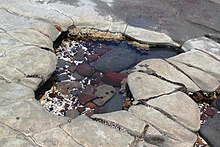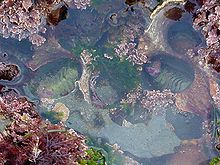Tide pool
Tide pools (GZT) and rock pools (RP) (so-called lithotelms) represent extreme habitats in the Eu- to Supralittal (surf to splash zone) of rocky coasts. Both rock pools and tide pools have no permanent inflow from the open sea ("fresh water").
The tidal pools located in the lower to middle eulittoral are usually supplied with fresh water on a regular basis during high tide. In contrast, the rock pools of the upper eulittoral up to the boundary between the upper supralittoral and the terrestrial zone only receive fresh water via splash water, spray from the surf, during storm conditions or through precipitation.
The location of rock pools and tide pools thus shows the difficult site conditions to which the animals and plants living in them are exposed. While the inhabitants of tide pools have to fight against being driven out to sea by the current at high tide, it is important for the inhabitants of rock pools to be prepared against progressive drying out due to sun and wind and the associated increase in salinity in the pool. The latter problem cannot be ruled out for tide pools either. Even if the danger of complete desiccation is not so great here, at least the temperature in the tide pool will rise significantly during prolonged exposure to sunlight compared to that in the open sea.
Thus, the most important abiotic environmental factors for rock pools and tide pools are:
- Solar radiation
- Wind
- Precipitation
- Contact with fresh water
The latter point depends on the height of the pond or pool above sea level (HH), as well as its distance from the sea. Precipitation plays an important role, since freshwater from rain (Sal 0.5 ‰) can sweeten rock pools or tide pools. In part, the fresh water is able to form a reasonably uniform layer of lower salinity over the denser salt water due to lower density.
In addition to the abiotic factors mentioned above, biotic factors also have a strong influence on the environment in rock pools and tide pools. For example, the density of the plants living in them (algae and autotrophic plankton) increases the oxygen content (O2) through increased photosynthesis. At the same time, the pH value also increases, since O2 is obtained through the decomposition of carbon dioxide (CO2) dissolved in the water as carbonic acid (H2CO3), i.e. the water becomes less acidic. In contrast, heterotrophic organisms in tide pools and rock pools lower the pH by consuming O2 and producing CO2. The fluctuations of the pH value in the diurnal rhythm, however, can be explained almost exclusively by the photosynthesis rate increasing during the day when there is strong sunlight.
Since, as mentioned above, life in rock pools and tide pools poses many dangers, the inhabitants rely on special adaptation mechanisms. These often include methods of protection against drought, for example, when there is no longer contact with water after a tide pool has dried out. In such a case, the equine actinia (Actinia equina) retracts its tentacles, assumes a spherical shape and can lie dry for a certain time in this way, similar to the dwarf periwinkle (Littorina neritoides), which uses its mantle cavity, rich in blood vessels, for respiration, and also closes its shell with an operculum. However, the inhabitants of rock pools and tide pools have to tolerate certain fluctuations, especially in salinity and temperature. The larvae and pupae of the mosquito species Aedes mariae have the greatest tolerance to salinity fluctuations.

Tidepool on Gabriola Island, Canada

Naturally Educated Rock Pool

View into a tide pool near San Diego, California (USA), with seaweed and two beetle snails
See also
- Rockpool, in Australia artificially created basins, which are used as swimming pools
Questions and Answers
Q: What are rock pools?
A: Rock pools, also known as tide pools, are rocky pools adjacent to the sea that are filled with seawater during high tides and exist as separate pools at low tide.
Q: What is the intertidal zone?
A: The intertidal zone is the zone between high tide and low tide where the ocean meets the land.
Q: What kind of animals live in rock pools?
A: Rock pools are habitats of uniquely adaptable animals that have engaged the special attention of naturalists and marine biologists.
Q: Why have rock pools engaged the special attention of naturalists and marine biologists?
A: Rock pools are habitats of uniquely adaptable animals that have engaged the special attention of naturalists and marine biologists.
Q: What happens to rock pools during low tide?
A: During low tide, the rock pools exist as separate pools.
Q: What happens to rock pools during high tide?
A: During high tide, the rock pools are filled with seawater.
Q: Where are rock pools located?
A: Rock pools are located in the intertidal zone, which is the zone between high tide and low tide where the ocean meets the land.
Search within the encyclopedia